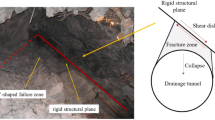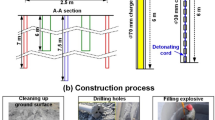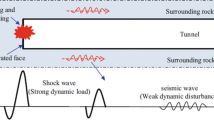Abstract
Block-flexure toppling is the most common toppling mode occurring in interbedded anti-inclined slopes. With the development of hydropower projects in Southwest China, numerous deep-seated large-area toppling failures have become revealed along the Yalong River, seriously threatening the construction and operation of hydropower infrastructure. With the Mari landslide as the research focus, a geological field investigation, base friction physical model test, and numerical simulation test were carried out to study the evolutionary process of slope failure. The results demonstrate that the deep-seated toppling in the study area initiated and developed with the river downcutting process, and the landslide was the final result of the toppling deformation. The interbedded structure of layered rock masses, the steep slate foliations in the slope, and the cross joints in the metamorphic quartz sandstone perpendicular to the rock layer are the controlling factors of the toppling deformation. The landslide induced by toppling mainly developed in the highly deformed zone, where multiple failure surfaces developed, and the location and shape of the failure surfaces were controlled by the cross joints in the metamorphic quartz sandstone. The evolutionary process of the deep-seated large-area toppling in the study area mainly underwent four stages: the initial slope formation stage, the rock column bending and cracking stage, the failure surface penetration stage, and the failure stage.

















Similar content being viewed by others
Data Availability
Data will be made available on request.
References
Adhikary DP, Dyskin AV, Jewell RJ, Stewart DP (1997) A study of the mechanism of flexural toppling failure of rock slopes. Rock Mech Rock Eng 30(2):75–93. https://doi.org/10.1007/BF01020126
Alejano LR, Alonso E (2005) Application of the’ shear and tensile strength reduction technique’ to obtain factors of safety of toppling and footwall rock slopes. Impact of Human Activity on the Geol Environ-Proc Int Symp Int Soc Rock Mech, Eurock 2005:7–13
Alejano LR, Sánchez-Alonso C, Pérez-Rey I, Arzúa J, Alonso E, González J, Ferrero AM (2018) Block toppling stability in the case of rock blocks with rounded edges. Eng Geol 234:192–203. https://doi.org/10.1016/j.enggeo.2018.01.010
Alzo’ubi AK, Martin CD, Cruden DM (2007) A discrete element damage model for rock slopes. In: Eberhardt E, Stead D, Morrison T (eds) Rock mechanics: meeting Society’s challenges and demands. Taylor & Francis, pp 503–510
Alzo’ubi AK, Martin CD, Cruden DM (2010) Influence of tensile strength on toppling failure in centrifuge tests. Int J Rock Mech Min Sci 47(6):974–982. https://doi.org/10.1016/j.ijrmms.2010.05.011
Amini M, Ardestani A, Khosravi MH (2017) Stability analysis of slide-toe-toppling failure. Eng Geol 228:82–96. https://doi.org/10.1016/j.enggeo.2017.07.008
Amini M, Golamzadeh M, Khosravi M (2015) Physical and theoretical modeling of rock slopes against block-flexure toppling failure. Int J Min Geo-Eng 49(2):155–171. https://doi.org/10.22059/IJMGE.2015.56103
Amini M, Majdi A, Veshadi MA (2012) Stability analysis of rock slopes against block-flexure toppling failure. Rock Mech Rock Eng 45(4):519–532. https://doi.org/10.1007/s00603-012-0220-7
Aydan Ö, Kawamoto T (1992) The stability of slopes and underground openings against flexural toppling and their stabilisation. Rock Mech Rock Eng 25(3):143–165. https://doi.org/10.1007/BF01019709
Aydan Ö, Shimizu Y, Ichikawa Y (1989) The effective failure modes and stability of slopes in rock mass with two discontinuity sets. Rock Mech Rock Eng 22(3):163–188. https://doi.org/10.1007/BF01470985
Azar Afza M, Ghazi Fard A, Asghari-Kaljahi E (2018) Modelling of progressive block-flexure toppling failure using numerical distinct element method (case study: South Pars special zone). Sci Quarterly J Iranian Assoc Eng Geol 10(1 & 2):61–73
Bray JW, Goodman RE (1981) The theory of base friction models. Int J Rock Mech Min Sci Geomech Abstr 18(6):453–468. Pergamon. https://doi.org/10.1016/0148-9062(81)90510-6
Brideau MA, Stead D (2010) Controls on block toppling using a three-dimensional distinct element approach. Rock Mech Rock Eng 43(3):241–260. https://doi.org/10.1007/s00603-009-0052-2
Cundall PA (1971) A computer model for simulating progressive, large-scale movement in blocky rock system. Proceedings of the international symposium on rock mechanics, vol 8, pp 129–136
De Freitas MH, Watter RJ (1973) Some field examples of toppling failure. Geotechnique 23(4):495–513. https://doi.org/10.1680/geot.1973.23.4.495
Fang K, Miao M, Tang H, Jia S, Dong A, An P, Zhang B (2023a) Insights into the deformation and failure characteristic of a slope due to excavation through multi-field monitoring: a model test. Acta Geotechnica 18(2):1001–1024. https://doi.org/10.1007/s11440-022-01627-0
Fang K, Tang H, Li C, Su X, An P, Sun S (2023b) Centrifuge modelling of landslides and landslide hazard mitigation: a review. Geosci Front 14:101493. https://doi.org/10.1016/j.gsf.2022.101493
Fumagalli E (1979) Geomechanical models of dam foundation. Proc Int Colloquium on Phys Geomech Models. Bergamo, Italy, pp 29-30
Goodman RE, Bray JW (1976) Toppling of rock slopes. Proc Specialty Conf Rock Eng Foundations and Slopes, vol 2. American Society of Civil Engineering, Boulder, pp 39–760
Huang, (2012) Mechanisms of large-scale landslides in China. Bull Eng Geol Env 71:161–170. https://doi.org/10.1007/s10064-011-0403-6
Liu M, Liu F, Huang R, Pei X (2016) Deep-seated large-scale toppling failure in metamorphic rocks: a case study of the Erguxi slope in southwest China. J Mt Sci 13(12):2094–2110. https://doi.org/10.1007/s11629-015-3803-4
Muller L (1968) New considerations on the Vaiont slide. Rock Mech Eng Geol 6(1–2):29–91
Ning Y, Tang H, Wang F, Zhang G (2019) Sensitivity analysis of toppling deformation for interbedded anti-inclined rock slopes based on the Grey relation method. Bull Eng Geol Env 78(8):6017–6032. https://doi.org/10.1007/s10064-019-01505-2
Ning Y, Tang H, Zhang B, Shen P, Zhang G, Xia D (2020) Investigation of the rock similar material proportion based on orthogonal design and its application in base friction physical model tests. Rock Soil Mech 41(6):2009. https://doi.org/10.16285/j.rsm.2019.1552
Ning Y, Tang H, Zhang G, Smit JV, Zhang B, Shen P, Chen H (2021) A complex rockslide developed from a deep-seated toppling failure in the upper Lancang River, Southwest China. Eng Geol 106329. https://doi.org/10.1016/j.enggeo.2021.106329
Sarfaraz H (2021) An analytical solution for analysis of block toppling failure using approach of fictitious horizontal acceleration. J Min Sci 57(2):202–209. https://doi.org/10.1134/S1062739121020046
Sarfaraz H (2020) Stability analysis of block-flexure toppling of rock blocks with round edges. J Min Environ 11(4):1217–1229. https://doi.org/10.22044/jme.2020.10128.1951
Sarfaraz H, Amini M (2020) Numerical modeling of rock slopes with a potential of block-flexure toppling failure. J Min Environ 11(1):247–259. https://doi.org/10.22044/jme.2019.8887.1778
Sarfaraz H, Bahrami AR, Samani R (2022) Numerical modelling of slide-head-toppling failure using FEM and DEM methods. J Min Environ 13(1): 269–280. https://doi.org/10.22044/jme.2022.11698.2159
Tang HM, Wasowski J, Juang CH (2019) Geohazards in the three Gorges Reservoir Area, China - Lessons learned from decades of research. Eng Geol 261L:105267. https://doi.org/10.1016/j.enggeo.2019.105267
Tu G, Deng H (2020) Characteristics of a deep-seated flexural toppling fracture and its relations with downcutting by the Lancang River: a case study on a steeply dipping layered rock slope, Southwest China. Eng Geol 275:105754. https://doi.org/10.1016/j.enggeo.2020.105754
Tu G, Deng H, Shang Q, Zhang Y, Luo X (2021) Effect of unloading in two directions on the formation of a deep-seated flexural toppling failure. Int J Rock Mech Min Sci 142:104790. https://doi.org/10.1016/j.ijrmms.2021.104790
Wang D, Tang H, Zhang Y, Shen P (2019) Local failure probability of the anti-dip slope susceptible to flexural toppling. Stoch Env Res Risk Assess 33(4):1187–1202. https://doi.org/10.1007/s00477-019-01683-1
Wong RHC, Chiu M (2001) A study on failure mechanism of block-flexure toppling by physical modelling testing. DC Rocks 2001, The 38th US Symposium on Rock Mechanics (USRMS). OnePetro, pp 989–995
Wyllie DC (1980) Toppling rock slope failures examples of analysis and stabilization. Rock Mech 13(2):89–98. https://doi.org/10.1007/BF01238952
Zhang G, Wang F, Zhang H, Tang H, Li X, Zhong Y (2018) New stability calculation method for rock slopes subject to flexural toppling failure. Int J Rock Mech Min Sci 106:319–328. https://doi.org/10.1016/j.ijrmms.2018.04.016
Zhang J, Chen Z, Wang X (2007) Centrifuge modeling of rock slopes susceptible to block toppling. Rock Mech Rock Eng 40(4):363–382. https://doi.org/10.1007/s00603-006-0112-9
Zheng Y, Chen C, Liu T, Zhang H, Sun C (2019) Theoretical and numerical study on the block-flexure toppling failure of rock slopes. Eng Geol 263:105309. https://doi.org/10.1016/j.enggeo.2019.105309
Zheng Y, Chen C, Meng F, Zhang H, Xia K, Chen X (2020) Assessing the stability of rock slopes with respect to block-flexure toppling failure using a force-transfer model and genetic algorithm. Rock Mech Rock Eng 53(8):3433–3445. https://doi.org/10.1007/s00603-020-02122-2
Zhu C, He M, Karakus M, Cui X, Tao Z (2020) Investigating toppling failure mechanism of anti-dip layered slope due to excavation by physical modelling. Rock Mech Rock Eng 53(11):5029–5050. https://doi.org/10.1007/s00603-020-02207-y
Zhu W, Li Y, Li S, Wang S, Zhang Q (2011) Quasi-three-dimensional physical model tests on a cavern complex under high in-situ stresses. Int J Rock Mech Min Sci 48(2):199–209. https://doi.org/10.1016/j.ijrmms.2010.11.008
Zou Z, Luo T, Zhang S, Duan H, Li S, Wang J, Deng Y, Wang J (2023) A novel method to evaluate the time-dependent stability of reservoir landslides: exemplified by Outang landslide in the Three Gorges Reservoir. Landslides 1–16. https://doi.org/10.1007/s10346-023-02056-0
Funding
This research was supported by the National Key Scientific Instrument and Equipment Development Projects of China (No. 41827808) and the Major Program of the National Natural Science Foundation of China (Nos. 42090055 and 42077268).
Author information
Authors and Affiliations
Corresponding author
Ethics declarations
Conflict of interest
The authors declare no competing interests.
Additional information
Highlights
• We studied the evolutionary process of the interbedded anti-inclined slope failure in the study area by a geological field investigation, base friction physical model test, and numerical simulation test;
• The evolutionary process of the deep-seated large-area toppling in the study area considering the river downcutting process is divided into four stages;
• The landslide forming in the deep-seated large-area toppled slope mainly develops in the highly deformed zone and has multiple failure surfaces;
• Block-flexure toppling is the primary deformation mode of interbedded anti-inclined slopes in the study area, in which cross joints in the metamorphic quartz sandstone control the shape and location of the failure surface.
Rights and permissions
Springer Nature or its licensor (e.g. a society or other partner) holds exclusive rights to this article under a publishing agreement with the author(s) or other rightsholder(s); author self-archiving of the accepted manuscript version of this article is solely governed by the terms of such publishing agreement and applicable law.
About this article
Cite this article
Zhang, B., Ning, Y., Tang, H. et al. Study on the evolutionary process of interbedded anti-inclined slope block-flexure toppling in the upper Yalong River. Bull Eng Geol Environ 82, 240 (2023). https://doi.org/10.1007/s10064-023-03223-2
Received:
Accepted:
Published:
DOI: https://doi.org/10.1007/s10064-023-03223-2




